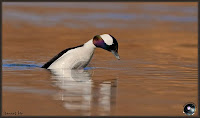The Bufflehead: Canada’s Smallest Diving Duck
 Common name: Bufflehead
Common name: Bufflehead
Latin name: Bucephala albeola
Range: Coast to coast
Size: Has a wing length of 168 mm and weighs between 272–635 g
Population estimate: Continental estimate of 1.4 million birds in 2004
Lifespan: 15 years
Buffleheads, or ‘butterballs’ as some hunters like to call them because of the amount of fat their bodies store during migration (115 g – almost 20% of their mass!), are one of the scarcest birds in North America. These black and white ducks are known to be highly active, hardly ever giving themselves a break, and nest in small cavities such as the holes vacated by Flickers. Their diet in freshwaters consists of arthropods such as insect larvae, and in salt water, small shrimps, crabs and amphipods.
Buffleheads usually occur in groups of 10 or fewer, and have a coast-to-coast breeding range. However, in spring and summer, British Columbia and northern Alberta seem to be the preferred spots for breeding Buffleheads. In fall they migrate east, south and southeast, with the largest numbers migrating over the prairies making their way to the Atlantic. In winter, Buffleheads are found on Canada’s west coast, Lake Ontario and the southern coasts of New Brunswick and Nova Scotia. In the United States their wintering areas are from New Jersey to North Carolina in the east and Washington to central California in the west. Besides being the smallest ducks in Canada, Buffleheads are unique in their courtship displays and their punctuality in returning to their wintering grounds along the Pacific coast. During courtship, males fly over females while fluttering their wings and then land in a ‘water-skiing’ motion, displaying both their feet and plumage (see photo on left). Buffleheads are a monogamous species, remaining with the same mate for a few years.
Besides being the smallest ducks in Canada, Buffleheads are unique in their courtship displays and their punctuality in returning to their wintering grounds along the Pacific coast. During courtship, males fly over females while fluttering their wings and then land in a ‘water-skiing’ motion, displaying both their feet and plumage (see photo on left). Buffleheads are a monogamous species, remaining with the same mate for a few years.
According to a study carried out by James Finley, the Caretaker of Sidney Channel Important Bird Area (IBA), Buffleheads arrive at Shoal Harbour Migratory Bird Sanctuary on Vancouver Island on the 298th day of the year, every year – that is punctual! The 298th day of the solar cycle equates to October 15th, which has come to be known as the All Buffleheads Day.
Quick fun facts:
– The species’ name is apparently due to their domed heads and was originally Buffalo Head.
– They are also known as Bumblebee Dippers, Robin Dippers, Hell-divers and Spirit Ducks.
– The Bufflehead’s genus, Bucephala, is said to be closely associated to the name of Alexander the Great’s horse, Bucephalus or Buchephalas.




